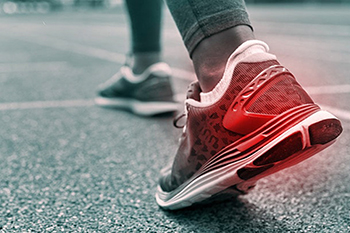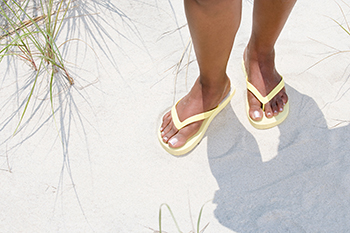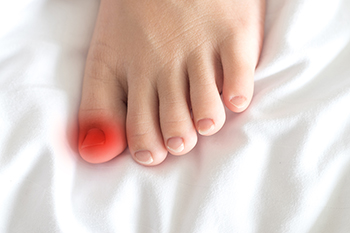Items filtered by date: November 2022
Wounds That Don't Heal Need to Be Checked
Joints in the Foot

Learning how the foot functions can be a critical step that individuals can take in understanding how they can best care for their feet. One important biomechanical aspect of how the foot functions is that each foot has a number of joints that serve different, important functions. Each toe has a certain number of joints, and interestingly, not all toes have the same number of joints. For example, the big toe has only two joints, while the other toes have three. The names of the three different joints found in toes besides the big toe are known as the metatarsophalangeal joint, the proximal interphalangeal joint, and the distal phalangeal joint. Joints form where bones meet and are covered by a certain amount of cartilage. For more information about joints in the feet and other facts about the biomechanics of the feet, contact a podiatrist today for more information.
If you have any concerns about your feet, contact Charles Perry, DPM from Ohio. Our doctor can provide the care you need to keep you pain-free and on your feet.
Biomechanics in Podiatry
Podiatric biomechanics is a particular sector of specialty podiatry with licensed practitioners who are trained to diagnose and treat conditions affecting the foot, ankle and lower leg. Biomechanics deals with the forces that act against the body, causing an interference with the biological structures. It focuses on the movement of the ankle, the foot and the forces that interact with them.
A History of Biomechanics
- Biomechanics dates back to the BC era in Egypt where evidence of professional foot care has been recorded.
- In 1974, biomechanics gained a higher profile from the studies of Merton Root, who claimed that by changing or controlling the forces between the ankle and the foot, corrections or conditions could be implemented to gain strength and coordination in the area.
Modern technological improvements are based on past theories and therapeutic processes that provide a better understanding of podiatric concepts for biomechanics. Computers can provide accurate information about the forces and patterns of the feet and lower legs.
Understanding biomechanics of the feet can help improve and eliminate pain, stopping further stress to the foot.
If you have any questions please feel free to contact our offices located in Cambridge and Zanesville, OH . We offer the newest diagnostic and treatment technologies for all your foot and ankle needs.
Swollen Feet and Sitting

The feet are resilient, yet delicate, parts of the human body. Without properly caring for them, we may be making our feet susceptible to a number of potentially harmful or uncomfortable foot afflictions. Swelling of the feet is one such affliction of the foot. When the feet swell, an individual might feel discomfort as the feet increase in size due to possible accumulation of fluids. One often overlooked cause of swollen feet is sitting for long durations of time. If you are the kind of person that, due to your job or lifestyle restrictions, must spend extended periods of time sitting down, there are steps you might take to mitigate foot swelling. For example, you might try to take breaks to move about while you are sitting or to perform leg extensions or knee lifts while sitting to facilitate blood circulation. For more information about swollen feet and sitting, contact a podiatrist today.
Swollen feet can be a sign of an underlying condition. If you have any concerns, contact Charles Perry, DPM of Ohio. Our doctor can provide the care you need to keep you pain-free and on your feet.
Swollen feet are a common ailment among pregnant women and people who stand or sit for extended periods. Aging may increase the possibility of swollen feet and patients who are obese often notice when their feet are swelling too. There may be medical reasons why swollen feet occur:
- Phlebitis - A condition that causes the veins to become inflamed and can also cause leg pain.
- Liver disease - This may lead to low blood levels of albumin which is a protein. This can cause fluid in the blood to pass into the tissues and several areas of the body can become swollen.
- Heart failure - When the heart doesn’t pump properly the blood that is normally pumped back to the heart can pool in the veins of the legs causing swollen feet.
- Kidney disease - One of the main functions of the kidneys is releasing excess fluid in the body. This type of condition can make it difficult for the kidneys to function properly, and as a result the feet may become swollen.
- Deep-vein thrombosis (DVT)- This is a serious condition where blood clots form in the veins of the legs. They can block the return of blood from the legs to the heart which may cause the feet to swell. It is important to be treated by a podiatrist if this condition is present.
Swollen feet can also be caused by bone and tendon conditions, including fractures, arthritis, and tendinitis. Additionally, there may be skin and toenail conditions and an infection may cause the feet to swell. Patients who take medicine to treat high blood pressure may be prone to getting swollen feet.
Many patients elevate their feet to help relieve the swelling and this is generally a temporary remedy. When a podiatrist is consulted the reason behind the swelling can be uncovered and subsequently treated.
If you have any questions please feel free to contact our offices located in Cambridge and Zanesville, OH . We offer the newest diagnostic tools and technology to treat your foot and ankle needs.
Buying Foot-Friendly Athletic Shoes

Shoes that do not fit well or those with high heels are a common cause of foot pain and can also lead to chronic conditions affecting other parts of the body. Athletes can prevent injury and pain by paying attention to a few tips that include making sure their shoes fit well and are supportive, selecting shoes that are appropriate for the activity to be done, and making any necessary adjustments to shoes prior to working out. It is important to pay close attention to shoe size and measure feet prior to trying shoes on. Feet swell as the day wears on, and shoe sizes vary across and between brands. Function and fit should be given precedence over fashion. Running shoes are different than hiking shoes and streetwear shoes are not the best for training. Different athletic shoes are developed to protect the areas of the feet that are most stressed by the activity. Shoe inserts, pads, or cups can be used in shoes to relieve chronic pain symptoms. If you enjoy running and want to continue your sport more comfortably, it is suggested you have your gait analyzed by a podiatrist. This healthcare practitioner can also observe any special adjustments needed for your shoes and advise on the best shoes for you.
You should always make sure your running shoes fit properly in order to avoid injury. For more information, contact Charles Perry, DPM from Ohio. Our doctor can provide the care you need to keep you pain-free and on your feet.
Choosing the Right Running Shoe for Your Foot Type
Improper shoe sizing can cause a myriad of problems for your feet. Shoes that don’t fit you properly can lead to muscular imbalances in your body, which can result in foot, knee, and hip injuries.
Tips for Finding the Right Running Shoe
- Make sure you have a thumb’s width of wiggle room between the end of your longest toe and the front of the shoe.
- There should be little to no slipping at the heel
- Don’t assume your size in one shoe brand will be your size in another
- Do not lace up your shoes too tightly
- Walk around in the store with your new shoes before you buy them
If you have any questions please feel free to contact our our offices located in Cambridge and Zanesville, OH . We offer the newest diagnostic and treatment technologies for all your foot and ankle needs.
Wearing Flip Flops Can Be Harmful to the Feet

Wearing flip-flops during the warmer months is simple, stylish, and convenient. Despite these fun facts, they can wreak havoc on your feet. Foot pain may gradually develop when flip-flops are frequently worn. Most flip-flops don't have arch support, and shock absorption is minimal. Additionally, they are not sturdy shoes, and the heels are not cushioned. The toes work hard to keep the flip-flops securely on the feet, and hammertoe may be a foot condition that develops as the toes bend to keep the shoe from slipping off. Flip-flops are designed in different styles, and it is suggested to choose sandals that have a back strap. This may help the toes to maintain balance instead of gripping the front of the shoe to stabilize the foot. If you have questions about what type of flip-flops to purchase, please confer with a podiatrist who can address any concerns you may have.
Flip-flops can cause a lot of problems for your feet. If you have any concerns about your feet or ankles, contact Charles Perry, DPM from Ohio. Our doctor will assist you with all of your foot and ankle needs.
Flip-Flops and Feet
Flip-flops have managed to become a summer essential for a lot of people. While the shoes may be stylish and easy to slip on and off, they can be dangerous to those who wear them too often. These shoes might protect you from fungal infections such as athlete’s foot, but they can also give you foot pain and sprained ankles if you trip while wearing them.
When Are They Okay to Wear?
Flip-flops should only be worn for very short periods of time. They can help protect your feet in places that are crawling with fungi, such as gym locker rooms. Athlete’s foot and plantar warts are two common fungi that flip-flops may help protect your feet against.
Why Are They Bad for My Feet?
These shoes do not offer any arch support, so they are not ideal for everyday use. They also do not provide shock absorption or heel cushioning which can be problematic for your feet. Additionally, you may suffer from glass cuts, puncture wounds, and stubbed toes since they offer little protection for your feet.
More Reasons Why They Are Bad for Your Feet
- They Slow You Down
- May Cause Blisters and Calluses
- Expose Your Feet to Bacteria
If you have any questions, please feel free to contact our offices located in Cambridge and Zanesville, OH . We offer the newest diagnostic and treatment technologies for all your foot care needs.
Why Do Ingrown Toenails Develop?

The big toe is generally affected when an ingrown toenail has developed. It happens when the nail grows into the skin instead of over it, and can cause severe pain and discomfort. Many people can get ingrown toenails from frequently wearing shoes that are too tight, or from trimming the toenails incorrectly. The skin surrounding the affected toenail may become inflamed, and is often red and swollen. Occasionally, there may be new tissue that grows over the toenail, and this is referred to as a granuloma. It may be accompanied by a discharge which can be blood or pus. Additionally, it may emit an odor if bacteria gets into the wound. Temporary relief may be found when the affected nail is soaked in warm water, followed by gently pushing the nail away from the skin using a cotton swab. For more severe infections, surgery may have to be performed that can permanently repair the nail. If you are afflicted with an ingrown toenail, please speak to a podiatrist as quickly as possible who can effectively treat this condition.
Ingrown toenails can become painful if they are not treated properly. For more information about ingrown toenails, contact Charles Perry, DPM of Ohio. Our doctor can provide the care you need to keep you pain-free and on your feet.
Ingrown Toenails
Ingrown toenails occur when a toenail grows sideways into the bed of the nail, causing pain, swelling, and possibly infection.
Causes
- Bacterial infections
- Improper nail cutting such as cutting it too short or not straight across
- Trauma to the toe, such as stubbing, which causes the nail to grow back irregularly
- Ill-fitting shoes that bunch the toes too close together
- Genetic predisposition
Prevention
Because ingrown toenails are not something found outside of shoe-wearing cultures, going barefoot as often as possible will decrease the likeliness of developing ingrown toenails. Wearing proper fitting shoes and using proper cutting techniques will also help decrease your risk of developing ingrown toenails.
Treatment
Ingrown toenails are a very treatable foot condition. In minor cases, soaking the affected area in salt or antibacterial soaps will not only help with the ingrown nail itself, but also help prevent any infections from occurring. In more severe cases, surgery is an option. In either case, speaking to your podiatrist about this condition will help you get a better understanding of specific treatment options that are right for you.
If you have any questions please feel free to contact our offices located in Cambridge and Zanesville, OH . We offer the newest diagnostic and treatment technologies for all your foot and ankle needs.

